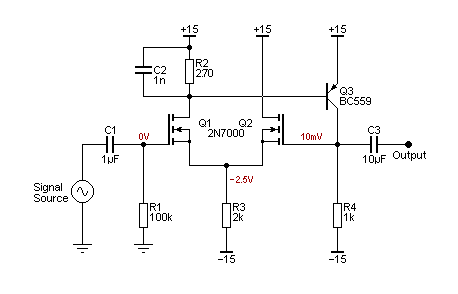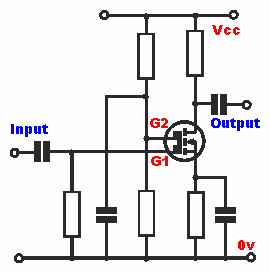One roadblock in this project is the oscillator circuit.
The oscillator oscillates rather well (if you accept the long power-up time) but the log Complete 18KHz source shows that there are some problems with the amplifier.
The single-MOSFET oscillator is very very sensitive to outside influences. The 10x probe doesn't affect it too much with the low capacitance and the 10M impendance but the gate of a MOSFET is something else, particularly the BS170 with 20 to 40pF that is coupled to whatever is in the circuit. So far the whole module doesn't work.
In the previous related log, I suggested a differential pair, which is a very interesting topology that I also study for #Germanium ECL and other BJT-based projects. I have found a very interesting description at https://en.wikibooks.org/wiki/Circuit_Idea/Revealing_the_Truth_about_ECL_Circuits that brings some more ideas to the table.
An interesting circuit:
Figure 13A - 'Ideal' Voltage Follower Using MOSFETs(courtesy of Elliott Sound Products)
but the feedback transistor should be a N or P-FET instead of PNP. I'm not sure how I will manage that.
Another chance find (it took a few days to realise) is inpired by the "tetrode" MOSFETs, such as the BS1012 (that's another story for later). While searching for informations about them, I found this page : http://www.radio-electronics.com/info/data/semicond/fet-field-effect-transistor/dual-gate-mosfet.php
"In effect, the dual gate MOSFET operation can be considered the same as
two MOSFET devices in series. Both gates affect the overall MOSFET
operation and hence the output."
I see this as a single-die AND gate but there is more to this part !
"The cascade amplifier helps overcome the Miller effect where capacitance is present between the input and output stages. Although the Miller effect can relate to any impedance between the input and output, normally the most critical is capacitance. This capacitance can lead to an increase in the level of input capacitance experienced and in high frequency (e.g. VHF & UHF) amplifiers it can also lead to instability.
The effect is overcome by using a cascade amplifier using a single
dual gate FET. In this configuration, biasing the drain-side gate at
constant potential reduces the gain loss caused by Miller effect. The
effects of capacitive coupling between the input and output are
virtually eliminated."
Reduced Miller effect ? That's interesting ! But what about coupling with other nodes ?
"Effectively a cascade amplifier is a two-stage amplifier formed from a
trans-conductance amplifier which is followed by a current buffer. This
provides a high level of input-output isolation, high input impedance,
high output impedance, higher gain or higher bandwidth when compared to a
single stage amplifier.
"
Now this is interesting and gives a clue about how to design an equivalent circuit !
Another explanation at http://electronics.stackexchange.com/questions/69300/how-does-a-dual-gate-mosfet-reduce-miller-effect provides this diagram:

The voltages and resistor values must be changed and experimentally tested...
There is one interesting conclusion to draw for the "high impedance amplifier" case : there are at least 2 transitors
- in series (for the trans-conductance case shown above)
- in parallel (for the differential pair)
That's two topologies that I have to test and compare !
 Yann Guidon / YGDES
Yann Guidon / YGDES


Discussions
Become a Hackaday.io Member
Create an account to leave a comment. Already have an account? Log In.
18kHz is audio frequency. May be easier to build discrete MOSFET opamp and then use opamp crystal oscillator circuits.
Are you sure? yes | no
Maybe audio for you; I doubt I can hear 18 kHz anymore :-)
Are you sure? yes | no
I didn't say hearing range. :P
Are you sure? yes | no
The ringing in my ears from shooting years ago might be about that high :-)
Are you sure? yes | no
Well, the oscillator works :-) the amplifier is the problem now. I want to KISS but the learning experience is the interesting part :-)
Are you sure? yes | no
Just use the discrete MOSFET inside a CD4007. :P
Are you sure? yes | no
these are not dual-gate, right ? only connection to the bulk/substrate, which is different...
Are you sure? yes | no
You can build inverter that actually works well for oscillators and buffers as they are the same ones used in the 40XX series. Also read type of applications (no sample circuits).
Are you sure? yes | no
I've used the dual-gate MOSFETs in RF circuits before. They're difficult to find in through-hole cases these days :(
They also have *two* gates you can fry with static, as if one wasn't bad enough :-)
Are you sure? yes | no
but they pack one NAND2 gate in one 4-pins package, just add a resistor ;-)
Are you sure? yes | no
Now you gave me an idea ... this is going to be expensive.
There are commercial single-gate packages now:
https://www.fairchildsemi.com/datasheets/NC/NC7SZ00.pdf
Texas Instruments has a line of them, too. What about a homebrew CPU made from them? All NAND or NOR for style points, or use any available gates for ease-of-design.
Are you sure? yes | no
I've had this idea before you, maybe 10+ years ago while looking at samples that TI sent me, but this is not such an amazing idea from the point of view of routing because from experience, the power tracks will create a mess with the data lines.
However making a computer out of BF1012 is more interesting and intriguing :-D
Are you sure? yes | no
Anyway, with enough search and luck, one could find cheap reels of single-gate packages, such as those I use for #DYPLED
Are you sure? yes | no
Oh, part of the expense is the four-layer PCBs. Power planes, not tracks :-)
Are you sure? yes | no
yeah but... it's still a bit of "cheating", as in "too easy", where is the glory ? :-D
you could even use an EDA toolsuite to generate a netlist that gets autorouted and then, instead of ASIC or FPGA cells, you use SOT23 parts.
Yeah, too easy, but I suspect it would be a worthy challenge for you :-P
Are you sure? yes | no
Carl Sagan said "To make an apple pie from scratch, first, you have to create the universe."
Are you sure? yes | no
what a nerd he was :-P
"To not make an apple pie, first, you have to create the universe. By committy"
Are you sure? yes | no